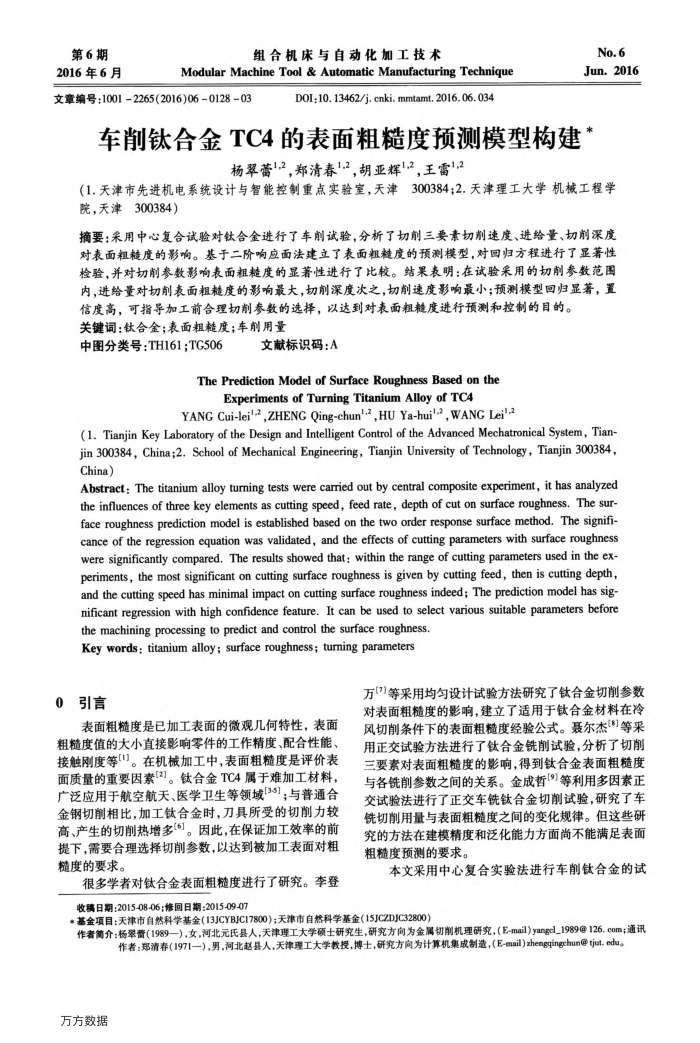您当前的位置:首页>论文资料>车削钛合金TC4的表面粗糙度预测模型构建
内容简介
 第6期 2016年6月
第6期 2016年6月组合机床与自动化加工技术
ModularMachineTool&AutomaticManufacturingTechnique
文章编号:10012265(2016)06012803
D0I;10.13462/j.cnki. mmtamt.2016.06.034
No.6 Jun.2016
车削钛合金TC4的表面粗糙度预测模型构建
杨翠蕾1,2,郑清春12,胡亚辉12,王雷1,2
(1.天津市先进机电系统设计与智能控制重点实验室,天津300384;2.天津理工大学机械工程学院,天津300384)
摘要:采用中心复合试验对钛合金进行了车削试验,分析了切削三要素切制速度、进给量、切削深度对表面粗糙度的影响。基于二阶响应面法建立了表面粗糙度的预测模型,对回归方程进行了显著性检验,并对切削参数影响表面粗糙度的显著性进行了比较。结果表明:在试验采用的切削参数范图内,进给量对切削表面粗糙度的影响最大,切削深度次之,切削速度影响最小;预测模型回归显著,置
信度高,可指导加工前合理切制参数的选择,以达到对表面租趋度进行预测和控制的目的。关键词:钛合金;表面粗糙度;车削用量
中图分类号:TH161;TG506
文献标识码:A
The Prediction Model of Surface Roughness Based on the
Experiments of Turning Titanium Alloy of TC4
YANG Cui-lei'-2,ZHENG Qing-chun'-2 , HU Ya-hui'->, WANG Lei'-2
(1. Tianjin Key Laboratory of the Design and Intelligent Control of the Advanced Mechatronical System, Tian jin 300384, China;2. School of Mechanical Engineering, Tianjin University of Technology, Tianjin 300384, China)
Abstract: The titanium alloy turning tests were carried out by central composite experiment, it has analyzed the influences of three key elements as cutting speed, feed rate, depth of cut on surface roughness. The sur-face roughness prediction model is established based on the two order response surface method. The signifi cance of the regression equation was validated, and the effects of cutting parameters with surface roughness were significantly compared. The results showed that: within the range of cutting parameters used in the ex-periments, the most significant on cutting surface roughness is given by cutting feed, then is cutting depth, and the cutting speed has minimal impact on cutting surface roughness indeed; The prediction model has sig nificant regression with high confidence feature. It can be used to select various suitable parameters before
themachining processing to predict and control the surface roughness. Keywords;titanium alloy;surfaceroughness;tumingparameters
0引言
表面粗糙度是已加工表面的微观几何特性,表面粗糙度值的大小直接影响零件的工作精度、配合性能、接触刚度等。在机械加工中,表面粗糙度是评价表面质量的重要因素[3]。钛合金TC4属于难加工材料,广泛应用于航空航天、医学卫生等领域(35];与普通合金钢切削相比,加工钛合金时,刀具所受的切削力较高、产生的切削热增多(‘)。因此,在保证加工效率的前提下,需要合理选择切削参数,以达到被加工表面对粗糙度的要求。
很多学者对钛合金表面粗糙度进行了研究。李登
万[7]等采用均匀设计试验方法研究了钛合金切削参数对表面粗糙度的影响,建立了适用于钛合金材料在冷风切削条件下的表面粗糙度经验公式。衰尔杰*)等采用正交试验方法进行了钛合金铣削试验,分析了切削三要素对表面粗糙度的影响,得到钛合金表面粗糙度与各铣削参数之间的关系。金成哲[)等利用多因素正交试验法进行了正交车铣钛合金切削试验,研究了车铣切削用量与表面粗糙度之间的变化规律。但这些研究的方法在建模精度和泛化能力方面尚不能满足表面粗糙度预测的要求。
本文采用中心复合实验法进行车削钛合金的试
收稿日期:2015-08-06;修回日期:2015-09-07
*基金项目:天津市自然科学基金(13JCYBJC17800);天津市自然科学基金(15JCZDJC32800)
作者简介:杨翠警(1989一),女,河北元氏县人,天津理工大学硕士研究生,研究方向为金属切削机理研究,(E-mail)yangcl_1989@126.com;通讯
作者:郑清春(1971一),男,河北赵县人,天津理工大学教授,博士,研究方向为计算机集成制造,(E-mail)zhengqingchun@tjut.edu。
万方数据